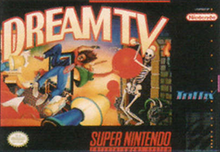Dream TV (video game)
| Dream TV | |
|---|---|
 Cover art | |
| Developer(s) | Bits Studios |
| Publisher(s) | Triffix |
| Designer(s) | Paul Hellier[2] Alex Martin[2] |
| Composer(s) | David Whittaker[3] |
| Platform(s) | Super NES |
| Release | |
| Genre(s) | Action |
| Mode(s) | Single-player Co-op |
Dream TV is an action video game for the Super NES where the player has to guide two youngsters through a nightmarish land of evil television shows (using a similar plot to the campy movie Stay Tuned and Crystal Dynamics' video game Gex). The player has to escape by defeating stereotypical television villains and finding pieces of a puzzle. The game features complex labyrinths.
Gameplay
[edit]National video gamers Charlie and Jimmy are given a strange-looking game cartridge game in the mail. When loading it in, the boys find themselves transported into the game.[4] They are sucked in by an evil being known as the Critic.[4] Now Jimmy and Charlie must fight for their lives through four Dream Worlds (Medieval, Egyptian, Prehistoric, and Future) if they hope to return home safely.[4] Dream TV is an action-adventure puzzle video game with elements of ToeJam & Earl (1991), World of Illusion (1992), and The Lost Vikings (1993).[5][6] It incorporates a split screen for both its single-player and two-player modes. Similar to The Lost Vikings, the game involves the player controlling two characters, one of which moves via the L and R buttons.[6][7] Collecting nine hidden puzzle pieces from each level will take the guys to the final showdown with the Critic and hopefully back to reality.[4]
Development
[edit]GamePro first announced Dream TV in its October 1992, revealing its premise of kids getting sucked into a television and reporting a planned release of fall 1992.[8]
Reception
[edit]| Publication | Score |
|---|---|
| AllGame | |
| GameFan | 166/400[9] |
| Nintendo Power | 11.2/20[5] |
| Video Games (DE) | 49%[10] |
| VideoGames & Computer Entertainment | 8/10[11] |
Reviews from Nintendo Power and VideoGames: The Ultimate Gaming Magazine praised its distinct utilization of the split-screen method, but felt it could've been better.[5][11] Nintendo Power reported situations where two different areas of a level that looked the same time could confuse players, and that a player character could still get hit even if offscreen.[5] The review also criticized the items' lack of clear purpose.[5]
Other critics, although acknowledging the unique split-screen, were not as favorable and felt the experience was worsened by other factors.[7][9] Critics found the character-switch mechanic aggravating to deal with, arguing it was easier to play the game in two-player mode.[9][7][10] Brett Alan Weiss of AllGame noted other several issues, such as the awkward controls, bland items, "poorly drawn and unimaginative" graphics that look like they're from a Master System title, uninteresting-to-fight enemies, and "mind-numbingly repetitive" music.[7] Critics from GameFan criticized its "ugly" and "tiny 8-bit" graphics, and "move to the left, move to the right action that goes nowhere",[9] and the German magazine Video Games called out its "pathetic" sprite animations, music and scarce sound effects.[10]
References
[edit]- ^ "Release date". GameFAQs. Retrieved 2008-09-30.
- ^ a b "Designer information". MobyGames. Retrieved 2012-01-10.
- ^ "Composer information". SNESMusic.org. Retrieved 2012-01-10.
- ^ a b c d "Basic game summary". IGN. Retrieved 2008-10-26.
- ^ a b c d e "Now Playing". Nintendo Power. Vol. 53. October 1993. pp. 100–105. Retrieved September 16, 2021.
- ^ a b "Dream TV". Video Games & Computer Entertainment. No. 58. November 1993. p. 51. Retrieved 16 September 2021.
- ^ a b c d e Weiss, Brett Alan. "Dream T.V. – Review". AllGame. Archived from the original on November 16, 2014. Retrieved September 16, 2021.
- ^ "Dream TV (SNES)". GamePro. No. 39. October 1992. p. 26. Retrieved 16 September 2021.
- ^ a b c d Skid; Sgt. Gamer; K. Lee; The Enquirer (November 1993). "Viewpoint". GameFan. Vol. 1, no. 11. pp. 10–11. Retrieved September 16, 2021.
- ^ a b c "Dream TV". Video Games (in German). August 1994. p. 101. Retrieved September 16, 2021.
- ^ a b "Dream TV". VideoGames: The Ultimate Gaming Magazine. No. 61. February 1994. p. 87. Retrieved September 16, 2021.
- 1994 video games
- Action games
- Bits Studios games
- Cooperative video games
- Multiplayer and single-player video games
- North America-exclusive video games
- Super Nintendo Entertainment System games
- Super Nintendo Entertainment System-only games
- Video games about video games
- Video games developed in the United Kingdom
- Video games scored by David Whittaker
